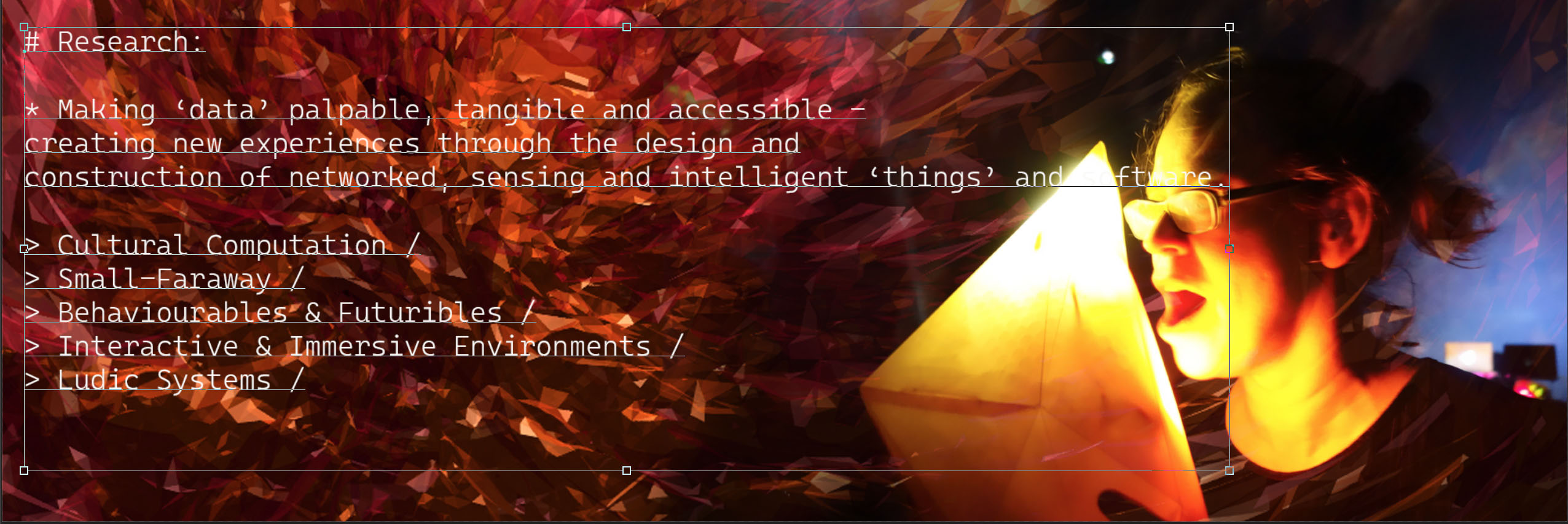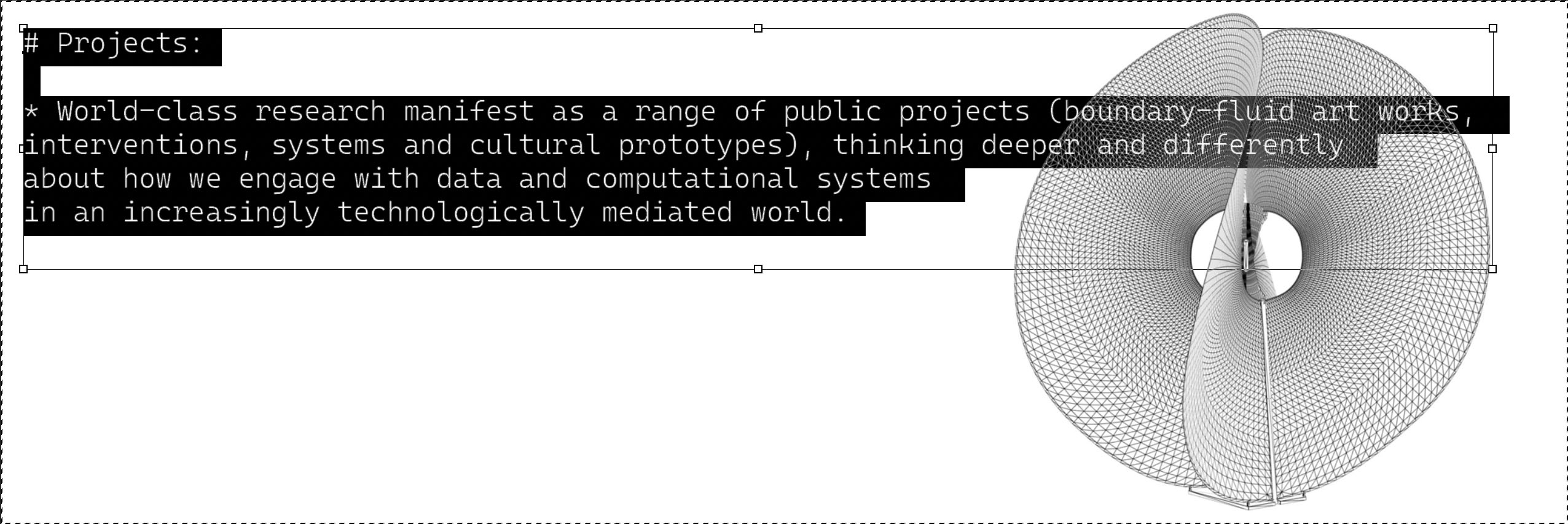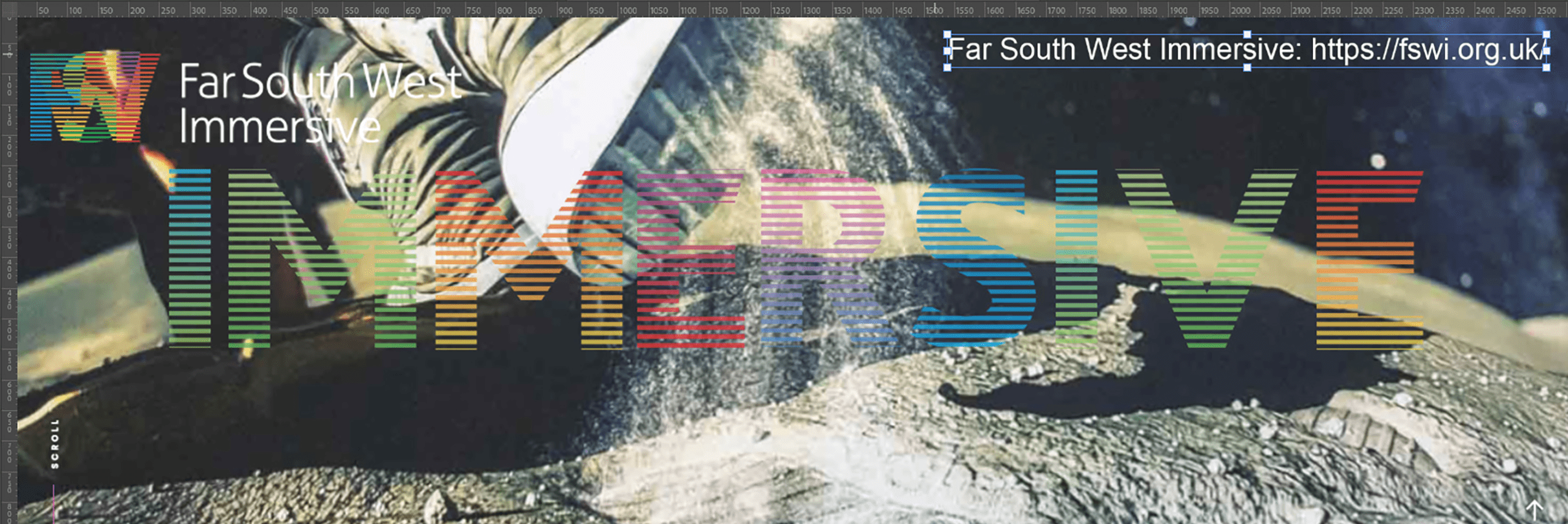
Research Excellence Framework (REF) 2014:
Unit of Assessment: 34 Art and Design: History, Practice and Theory.
i-DAT Operating Systems: Harvesting Data
Summary of the impact:
i-DAT has developed an open infrastructure for ‘harvesting’ and visualising data to support collaborative interdisciplinary projects in environmental, social and cultural contexts. Framed as a series of ‘Operating Systems’ this research contributes to the strategic activities of not-for-profit, public, private and community sectors, including Arts Council England, Plymouth City Council, UNESCO Biosphere and World Heritage Sites. Through i-DAT’s National Portfolio Organisation status, this research delivers significant audience numbers and new work and contributes to and can be measured against impacts in relation to civil society, cultural life, policy making, public services and, to a lesser extent, economic prosperity.
Underpinning research:
i-DAT’s underpinning research concerns are making ‘data’ generated by human, ecological, economic and societal activity tangible and readily available to the public, artists, engineers and scientists for artistic expression with a cultural and / or a social impact. It involves designing and constructing networked sensors and software platforms that focus on the significance that harvesting, processing and the manifestation of data can play in contemporary culture.
This practice-based approach engages pragmatically with people, communities and institutions through collaborative and participatory design methods and has been supported by a range of grant funding. The team led by Prof Mike Phillips, with B Aga (Director of Operations), Gianni Corino (Associate Professor) and Dr Simon Lock (Lecturer) explores the use of digital technologies to evaluate and measure the impact of human activity by building real-time models that incorporate quantitative and qualitative metrics.
The innovative ‘Operating Systems’ originate in the Arch-OS (2005) collaborative research project, which brought together architects, software engineers, artists and designers to create a real-time digital model of a building. This involved creating code to access closed industrial Building Energy Management Systems, developing new sensors and providing an open access platform to the data for further commissions. The research gave new insights into the social, cultural and ecological possibilities of coupling real-time data with physical objects and spaces and is evident through the design and construction ‘random’ lift button’s, a vision system to track building inhabitants, responsive robotic architecture, 3D audio system, experimental database design for streaming data to social networks and methods for visualising and sonifying the ecological footprint of a building.
Further iterations were developed in collaboration with international Architectural practices, engineers and Architecture Schools, leading to the ‘i-500’ public art commission which was opened in 2010 ($230,000 AU) for Curtin University’s new research building in Perth, WA. This research has subsequently been embedded in the EPSRC eViz project for the visualisation for carbon reduction) project (£1.8m) as a strategy for behavioural change.
Since 2008 elements of the Arch-OS system have been developed in a modular fashion each with a specific context and opportunities for new art works and audience engagement as for example: S-OS (2008-) [Social operating system] S-OS uses a range of analytical tools to explore the comparison of quantitative and qualitative data providing a platform for increased audience engagement, participation, and feedback at cultural and public events. Partners include Plymouth City Council, Cornwall Mining Heritage and Cheltenham Festivals.
Dome-OS (2009 -) The research has established new production processes, designed, coded, constructed, commissioned and curated software and hardware to visualise complex real-time data sets. Taking advantage of the Plymouth University’s Immersive Vision Theatre the research has been a catalyst for interdisciplinary collaborations within international FullDome community.
Bio-OS (2010 -) [Biological operating system] This harvests data from the body using specially developed biosensors, mobile phones, and real-time feeds to enable social gaming, performance, and medical collaborations and involves collaborations with commissioned artists, IBM and Deriford Hospital in Plymouth, and the Charity Rosetta Life.
Eco-OS (2010 -) [Ecological operating system] This collects environmental data through remote networked sensors (‘ecoids’) developed in-house by the research team. It has been used in funded projects with UNESCO Biosphere and World Heritage sites and provided a platform for an interdisciplinary dialogue between schools, the public, artists and scientists.
The various Operating Systems were consolidated into a single platform in 2010.
A series of exhibitions have applied the data capture and visualisation/sonification process developed through the research to scientific imaging narratives. Most notable among these are Phillips’s ‘Exposure’ Exhibition at UCLA Art Sci Centre (http://artsci.ucla.edu/?q=events/mike-phillips-lecture-exhibition-opening), his ‘spectre [ˈspɛktə/]’ at the Schauraum Wien, and his ‘A Mote it is…’ for Art in the Age of Nano Technology at the John Curtin Gallery, University of Technology, Perth (http://www.i-dat.org/a-mote-it-is-update/).
Details of the impact:
This research provides a platform for artists, technologists and scientists to develop new research and creative work. Its intention is to foster new relationships and collaborations with a range of stakeholders, disciplines and communities and has a wide variety of impacts.
In 2012 i-DAT (http://www.i-dat.org) secured Arts Council National Portfolio Organization status on the basis of this research, following a highly competitive national application process. The research consistently delivers well above ACE expectations as evidenced in the significant increase in audience numbers. Since 2008-2011 this research supported 215 artists with 4059 participants and an audience of 24178. This was generated through 608 exhibition days, 57 new commissions and 702 days of employment for artists and 319 training sessions. As an indicator of cultural impact i-DAT’s audience figures have increased from 5000 in 2011/12 to 1478,380 in 2012/13. Of this 1473,167 are online, and 5,213 offline. 882 CYP workshops and collaborations have been delivered.
Prof Phillips research is actively contributing to Policy Making through his involvement with Arts Council England’s cultural strategy, the regional Arts Council England SW Digital Reference Group, the TSB Internet of Things Special Interest Group and the AHRC Internet of Things Advisory Board. Strong relationships established with Arts organisations, artists, SME’s, Councils and the third sector on the back of this research provides significant economic impact. This includes sponsorship from IBM for the Smarter Planet R&D studio at Plymouth University.
Bio-OS supported a collaboration (2011) with the E-Health and Health Informatics research group at Plymouth University Faculty of Health, Derriford Hospital and IBM Smarter Planet to design a prototype intelligent catheter (‘iWee’) to address the costs to the NHS of treating catheter-induced infections.
S-OS Civil Society, Policy making and Public services impacts include a collaboration with Plymouth City Council (PCC) supporting the development of the city ‘Visitors Plan’ and ways to attract and support tourists. The research also assisted the PCC successful first stage TSB Future City Catapult (£50,000) and provided an information system to collect social network data and sentiment analysis for the British Art Show 7 (2011) and the Economic Impact report commissioned by PCC. This led to the Cheltenham Science Festival Keji (2012) installation and recently the NESTA Digital R&D award (£127,000 in cooperation with Cheltenham Festivals and Warwick University and supported by Facebook) for the Qualia Project, a real-time monitoring system to collate the economic, cultural and social impact of cultural events.
Eco-OS has contributed involved public engagement with schools through workshops and artists commissions. For example, Eco-OS provided the platform for the Confluence project (2011-12), funded by Leader 4 and Arts Council England, in collaboration with Beaford Arts, Appledore Arts, North Devon Biosphere Reserve, involving eight schools and four artists. According to Andrew Bell, Biosphere Reserve Coordinator, “A major benefit from the project was the trans-disciplinary working; which put the Biosphere Reserve scientific people in contact with technicians developing the sensors and the lead artists to explore and challenge ideas and concepts and provide new inspiration for portraying information (See source 5 below).
Dr Fish of the Centre for Rural Policy Research University of Exeter sees the Confluence Project as “part of the work enabling communities to orientate themselves towards the lived realities of environmental change and innovate within their changing circumstances.” and “as much as the rational technocracies of policy and decision making might otherwise imply, environment processes need to be felt as much as understood.” (See source 5 below). Extremely positive responses from the participants and audiences support this insight: “A way of stimulating the mind to look at the environment through data capture. Wow!” and “Gorgeous use of data. Dreamy, one minute I was flying then swimming underwater” (See source 5 below). The research facilitated 3 Village Hall roadshows, 39 workshops with schools with a total of 1673 people. The Confluence project’s audience engagement contributed to a £750,000 award to the North Devon Biosphere (totalling £3 million with partnership contributions) from DEFRA for a Nature Improvement Area.
Dome-OS has established an international fulldome festival, FULLDOMEUK (http://www.fulldome.org.uk/) which is the catalyst for an international network that is informing policy making in the fulldome community (led by IMERSA, USA), initiating new licensing, distribution and production and display technologies and practices. i-DAT’s work with real-time data is creating new opportunities for creative workers in the field and supporting interdisciplinary collaborations for scientific visualisation. This research has been consolidated by the establishment of the European Mobile Dome Lab for International Media Artists funded by the EU Culture Programme, Strand 1.3.5, €200k (project # 545974), 09/2013, with University of Applied Arts Vienna (lead), NTLab – University of Athens (GR), Trans-Media-Akademie Hellerau (DE), Society for Arts and Technology (CA) - Université Laval (CA).






You must be logged in to post a comment.